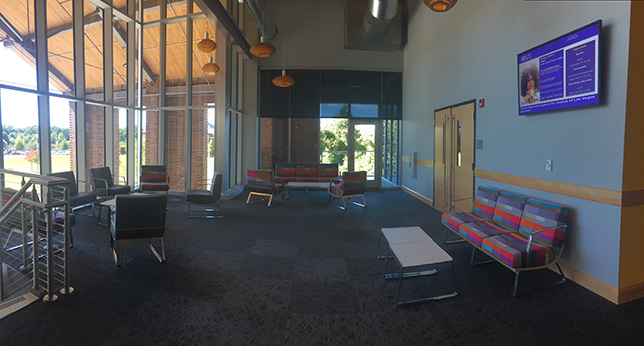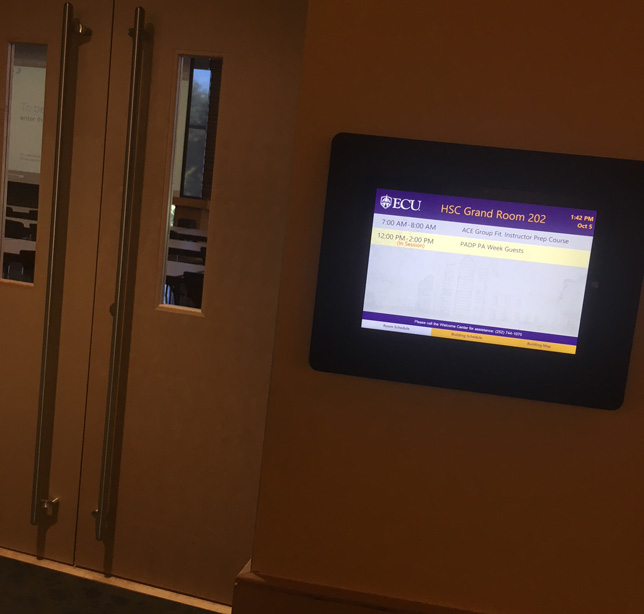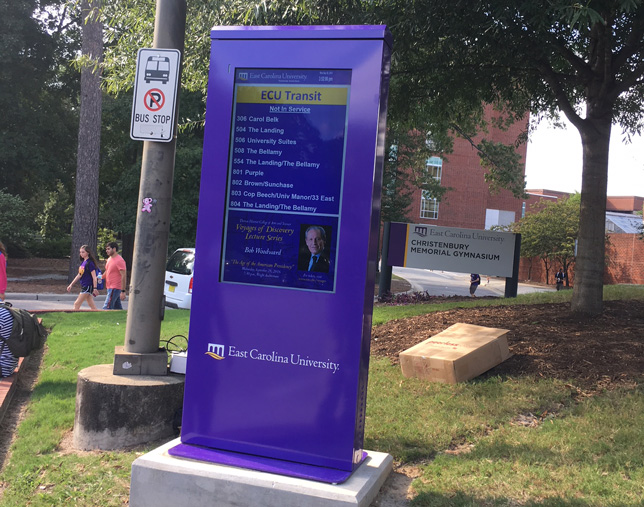3 Considerations for Effective Digital Signage in Higher Ed
Implementing a digital signage network on campus comes down to collaboration and communication — and working with stakeholders to get the content right.
- By Stephen Wright
- 01/17/18

Digital signage display in an East Carolina University student center lounge space
One of the keys to the success of major projects on college and university campuses is the need to work with people who have a stake in accomplishing the institution's collective goals. In higher education we often joke that there has to be a meeting to plan a meeting, or that there is a committee formed for everything. But the truth is that doing great things on campus requires collaboration with your peers — to harness their strengths in order to reach your goals. Digital signage is no exception.
Like most people, you have probably encountered digital signage in airports, retail spaces, public transit, and even on your own college campus. As this technology continues to grow and its value is realized, there will be a call for greater expansion of digital signage networks across campuses. When implementing a campus signage network, or deciding to combine existing networks, there are three major considerations that can provide insight into the process — and collaboration factors into all of them.
1) Identifying Stakeholders and Defining Roles
Identifying stakeholders and defining roles are two tasks that are closely related, but depending on the structure of a particular institution, these do not always involve identical groups of people. If this project is being viewed from an academic perspective, for example, stakeholders could certainly involve the deans of colleges, and probably some marketing groups. You may have a centralized IT infrastructure team in charge of getting either a wired or wireless data connection to your signs, but that could be viewed as their role even if no one in that group is thought to be a stakeholder.
The process of defining stakeholders and roles may not be completely concrete, but it is a vital step in establishing a campuswide network, because these networks are almost guaranteed to grow —and it is essential to know who plays what role when scaling and spreading into new locations. This process is also definitely an interactive one, in the sense that some of it will shift or roles and stakeholders will be added as the network grows into new locations. Some of the conversations that will come up when discussing stakeholders and roles are universal among colleges, such as budget, maintaining hardware, responsibility for maintaining content and more.
2) Content Management
Providing content, refreshing it and determining constantly what to say and how to present it is a never-ending task. And the larger the campus digital signage network becomes, the more need there is to define parameters for content management.
A campuswide digital signage solution affords the opportunity of having dynamic content flowing onto screens from many diverse sources, which can be zoned for placing specific messages only on certain screens. There is a need for a main content distributor, disseminating important marketing and informational materials to the entire network; you can also have departments publishing content to screens local to their college or office with information that may be more specifically relevant to that area. If there smaller departments that are not producing much content for their signage, they benefit from getting new, rich content flowing in from the central marketing team, which in turn helps keep their own content from becoming stale and unappealing.

Interactive digital room sign display outside the door of a large meeting space in ECU's new Health Sciences Student Center
Another added advantage to centralizing a campuswide digital signage network and establishing specific responsibilities is that when a campus department is hosting a large-scale event, that department can reach out via the predefined channels to get a message published to the entire campus advertising the event. Such cross-campus communication becomes increasingly difficult if there are separate networks in place on your campus.
3) Getting User Buy-in
Another aspect of collaboration is getting "buy-in" from your users. When users see the value of your centralized digital signage network, that helps discourage the small DIY projects that tend to pop up. Having to cobble together these small offshoots is one of the pain points of decentralization and creates a headache when trying to manage content across multiple systems.
Looking Ahead
Though it is rare to find colleges on the cutting edge of signage technology, they often are not far behind in adopting emerging technologies. Advanced wayfinding solutions, digital room signage and room scheduling systems, interactive kiosks, outdoor and large-format display technology (particularly for athletics and donor walls) and many others already becoming more commonplace on campuses around the country.

Outdoor transit signage displaying real-time bus information for ECU's campus transit system
As our users see these new and exciting technologies, requests for them are inevitable. It is essential that we, as technology or marketing professionals on our campuses, be prepared to effectively answer the call when the time comes. Whether the signage is already in place, or you believe the requests are coming down the line, it is in your best interest to learn what is out there and prepare to collaborate with the people around you to use the strengths of your colleagues to your advantage.
I encourage anyone with questions or anyone with input on the topic of digital signage in higher education to reach out to me so that we can expand the collaborative efforts beyond our own campuses and learn what is working from peer institutions. I can be reached via e-mail at [email protected].
About the Author
Stephen Wright, technology analyst, digital signage lead at East Carolina University, has contributed to the growth of digital signage at his institution for eight years. ECU now counts approximately 200 screens in a digital signage network that spans three campuses and also serves some off-campus areas.